Remembering Patrick O’Donnell: The Man who Avenged the Invincibles
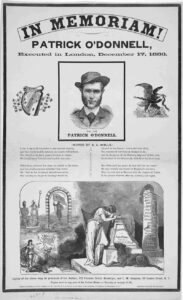
By John Joe McGinley
Patrick O’Donnell from the parish of Gaoth Dobhair in County Donegal was hanged at New Gate prison on the 17th of December 1883 for the murder of James Carey.
Carey was the leader of a republican group called the Invincible’s and his Queens evidence led to the hanging of 5 members of his group who were found guilty for what became known as the Phoenix Park murders.
Patrick O’Donnell was born in the Donegal townland of Min An Chladaigh on 1st September 1833. Little is known of his early life, but he was still a child when ‘an Gorta Mór’, the great famine, began in 1845.
Like so many of his fellow Irish men and women he was forced to flee Ireland as hunger and disease stalked the land.
Patrick In America
Patrick left Donegal for America when he was 16 years old. His uncle Manus had emigrated with his family earlier and had settled in the anthracite coal mining region of Pennsylvania.
Patrick O’Donnell emigrated to the America as a young man and lived New York, Philadelphia, Ohio and Toronto.
However, he did not go directly to his relatives. Like many of his fellow emigrants he found work on the east coast of America in Brooklyn New York and then Philadelphia. Trying his luck in Ohio he then moved to Canada, settling in Toronto. Despite his history of manual labour, he began to work in the hotel trade even at one stage becoming a butler.
This could explain why in later years people would assume his upright bearing was the result of military training, when in fact it was due to his time in domestic service.
He eventually re-joined his family in Schuylkill County, Pennsylvania. His uncle Manus had died in 1867 and his widow Margaret ran a boarding house with her sons James and Charles. Her daughter Erin and her husband Charles McAllister and young son also stayed with them. (1)
Another of his cousins Mary Anne was married to Jack Kehoe, the alleged king of the Molly Maguires. His American cousins worked as miners and joined the Molly Maguires fighting for improved working conditions in the harsh environment of the Pennsylvanian mines. The Molly Maguires were an Irish secret society named after anti-landlord activities in their native land.
They had originally formed in Ireland in the 1840s as a response to miserable working conditions and landlord evictions. They were the latest in a long line of rural secret societies including the Whiteboys and Ribbonmen.
In Pennsylvania many believed the Ancient Order of Hibernians (AOH) was the Molly Maguires’ cover or working name, which was recognized by the state as a legitimate organisation. Once an Irishman had proven himself in the AOH, he could then be inducted into the Molly Maguires. When the AOH could not make changes through legislation, the Molly Maguires allegedly tried to make changes through force. (2)
The Molly Maguires in America, though not officially affiliated with Clan na Gael or any Fenian organisation, were also strong supporters of Irish independence. Patrick’s family were key members of the Maguires and involved in some of the highest profile acts of sabotage in the struggle.
Patrick’s family and he himself were involved with the Irish secret society the Molly Maguires.
It was alleged that his cousins Charles and James had been involved in the murder of mine boss Thomas Sanger and miner William Uren on September 1st, 1875. This was widely known as having been conducted by the Molly Maguire’s in revenge for Sangers perceived ill treatment of mine workers. (3)
Thomas Sanger, foreman of Heaton’s Colliery in Raven Run near Girardville, and miner William Uren had been gunned down as they walked along an empty street to work. Sanger was targeted because of an alleged workplace grievance, while Uren, who boarded with the Sanger family, was slain to eliminate him as a witness.
The Mine owners had a determination to break the Maguires and brutal tactics including murder had not been uncommon from them.
On the night of 10th December 1875, a group of masked men attacked the O’Donnell boarding house and Patricks cousins Charles and Ellen died, in what was to become known as the Wiggins Patch Massacre.
Some members of the family escaped, including Patrick, and they resolved to retaliate against those involved in the maiming and murder of their friends and relations. This was not easy in a highly charged situation and it was clear that Patrick O’Donnell was now in grave danger.
Kevin Kenny in his book ‘Making sense of the Molly Maguire’s’ suggests it was at this stage that O’Donnell resolved to leave America and return to Ireland. (4)
Patrick first went to New York along with his cousin James who had escaped the attack on the boarding house. In New York Patrick heard of riches to be made in the diamond and gold mines in South Africa and decided to seek out a new life for himself. But first in May 1883 Patrick left America to visit his mother and brother who still lived in Donegal.
The Ireland O’Donnell returned to was still reeling from the turbulent events of a year earlier when the Chief Secretary of Ireland, Lord Frederick Cavendish and the Permanent undersecretary Thomas Henry Burke had been assassinated in what had become known as the ‘Phoenix Park murders’.
The Phoenix park murders
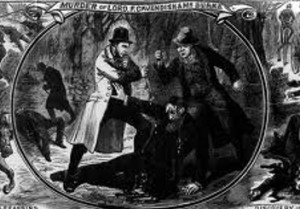
As Patrick O’Donnell planned to return to his native Donegal, little did he know as he sat in New York that across the Atlantic ocean in Dublin, murders were about to be committed that would change his life forever and eventually enter his name in to the annals of Irish history.
On a warm evening on the 6th of May 1882 Thomas Henry Burke, the most senior civil servant in Ireland decided to enjoy a walk through the Phoenix Park. He was unaware that assassins had decided he had to die, in the fightback against British repression in Ireland during the Land War – the agitation of tenant farmers against landlords.
In May 1882, the Invincibles, a Fenian off-shoot assassinated the two most senior British officials in Ireland in Dublin’s Phoenix Park, an event that was to shape Patrick O’Donell’s final years.
Burke had not been the original target, his assassins had originally intended to murder W.E Forster but he had recently resigned as Chief Secretary of Ireland, so Burke would have to do.
Burke was recognised as a hardworking and an efficient public servant, but he was also heavily involved in implementing what had been perceived as draconian action against the Land League during the first land war from 1879 onwards – especially the Coercion Act of 1881, which banned the Land League and under which its leaders were arrested.
Perhaps this was why he was targeted for assassination, but the ostensible reason was retaliation for the Royal Irish Constabulary opening fire on a protesting crowd at Ballina County Mayo.
The previous day the assassins had waited for Burke to enjoy his usual walk in Phoenix park, but he did not show, now they hoped for better luck. As it happened Burke was accompanied by Lord Frederick Cavendish, the newly appointed Chief Secretary for Ireland.
As both men walked through the park they were attacked and stabbed by a man who killed them both with a hospital scalpel. In what became to be known as the Phoenix park murders.
A republican group called the “Irish National Invincibles” claimed responsibility for the killings. The murder shook the British establishment to the very top, all the way to 10 Downing Street, who demanded retribution. (5)
Responsibility for the investigation into the killings was given to the British state’s premier policeman in Ireland, Superintendent John Mallon who headed up the notorious and feared G Division of Dublin Castle.
A Roman Catholic from County Armagh, Mallon’s ‘G’ division was a unit of plainclothes detectives who were often tasked with spying, recruitment of informers, prevention of political violence and apprehension of Irish republican political activists in the 19th century.
The initial suspects where several Fenian activists who had been recruited from abroad by leading members of the land league. Mallon a shrewd and tenacious detective, began interrogating them gradually piecing together the conspiracy. This information led him to James Carey who was quickly arrested.
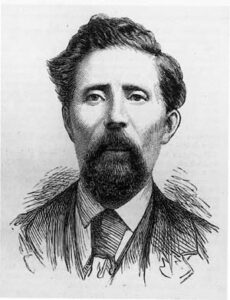
James Carey was a Dubliner who had started out as a brick layer before becoming a slum landlord. He had also been recently elected to the Dublin Corporation and was even spoken as a potential future mayor.
Careys fenian credentials were impeccable. He had been active in revolutionary circles as a member of the fenians since the 1860s. He had even taken part in the failed rebellion of 1867.
He had also been a leading member of the Irish Republican Brotherhood (IRB) rising to become its treasurer.
He left the IRB in 1881 following an argument on future strategy. Carey favoured a more direct approach to removing the British from Ireland and formed a new group called the Invincible’s, who would claim responsibility for the Phoenix Park murders.
In his book ‘Irish Conspiracies. Recollections of John Mallon’, Detective Mallon said of Carey.
“he was the only one among the conspirators capable of addressing a meeting. He appreciated the importance of appearances too; he smoked cigars and wore kid gloves on the journeys from prison to the courthouse”. (6)
Under pressure from Mallon and faced with a charge of murder and inevitable execution, James Carey chose to turn Queens Evidence and testify against his fellow conspirators.
British retribution was swift, because of Carey’s testimony, eight men were sentenced to penal servitude while five men were condemned to die. Between May and June 1883, Joe Brady, Daniel Curley, Thomas Caffrey, Michael Fagan and Tim Kelly all hanged at Kilmainham jail.
As for Carey he was now a problem for the British establishment. He had been given a pardon and a new identity, but he could not stay in Ireland. Other possible homes such as America, Canada and Australia where ruled out due to the Fenian networks operating in them.
It was decided that Carey and his family would be given a new life in the Natal region of South Africa. The British spirited away Carey’s wife and their seven children and they were placed in a lodging house in the East End of London. As for Carey he was safe in Kilmainham Gaol waiting for the travel arrangements to be finalised.
Mrs Carey and five of the children were put aboard the steamer Kinfauns Castle in London as steerage passengers and Carey and his two eldest children joined the ship at Dartmouth, all of them travelling as a family under the name of Power, Mrs Carey’s maiden name, bound for Cape Town. (7)
Little did they know that a fellow passenger was Patrick O’Donnell who was journeying to South Africa to forge a new life in the Diamond and Gold Mines of Natal.
The journey to Cape Town
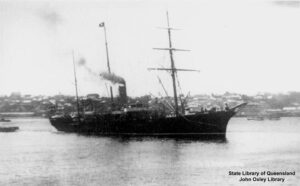
O’Donnell and his cousin had returned from New York to visit his Mother in Gweedore. James returned to America, but Patrick had already decided to try his luck in the diamond mines of South Africa.
He first went to Derry then Liverpool and finally onto London where he met another Donegal native Susan Gallagher. Patrick proposed and suggested that Susan accompany him to make a new life in south Africa. They could not be married as O’Donnell already had a wife in America, they none the less booked passage on the Kinfauns Castle as Mr and Mrs Patrick O’Donnell.
On the long voyage James Carey or as he was now known ‘James Power’, kept his true identity a nervous secret. As the Kinfauns Castle made its way to Cape Town, it was no surprise that Patrick O’Donnell and James Carey mingled together. Witnesses later testified that they became friendly, played dice and cards and spent many nights drinking together.
O’Donnell found himself on the same ship to South Africa, as James Carey, the Invincible member who had informed on his colleagues, resulting in their execution.
At Cape Town before the passengers were transferred to a coastal steamer Melrose to complete the voyage to Natal, the O’Donnell’s and the Carey family had time to go ashore.
Patrick O’Donnell and James Carey decided to go drinking and in a Cape Town Bar, it was there that James Careys mask as James Power slipped.
As the drink took hold, Carey began singing Irish songs and ranting against English injustice. In a drunken rage he pulled a revolver while arguing with English patrons and a brawl broke out.
Another passenger from the Kinfauns Castle by the name of Robert Cubitt was told by the angry bar owner that Powers true identity was James Carey. To back up his claim he produced a picture of Carey from the Dublin Weekly Freeman of 5th of May that covered the Invincibles trial and told of Carey turning Queens evidence.
Cubitt immediately showed the picture to O’Donnell who despite showing no anger or concern was heard to say:
“I’ll shoot him” (8)
Irish nationalists, both committed and otherwise, whether based in Ireland, America or elsewhere, were passionate in their denunciation of Carey. Was it this anger that provoked Patricks statement? Or was it guilt?
O’Donnell had been a Molly Maguire; he had seen the injustices meted out by the mine owners and he had even witnessed members of his own family brutally murdered by hired killers.
Having failed to avenge them, was his reaction a form of penance where he would seek retribution for his relatives and the 5 men hanged by Careys evidence and betrayal?
Carey had no idea his cover was blown but as the passengers embarked on the Melrose, rumour was rife in Cape Town that James Power was in fact James Carey the Invincible and traitor.
The Melrose left Cape Town on the 28th of July 1883 and it did not take long for Patrick O’Donnell to act.
The Murder of James Carey
On the afternoon of the 29th of July 1883, the Melrose was off the coast of Table Bay. Patrick O’Donnell and James Carey were playing cards and having a drink in the saloon bar.
Suddenly the card table was overturned, and shots rang out.
O’Donnell shot Carey first in the neck using a revolver he had smuggled aboard. As Carey staggered from the table and tried to flee, Patrick rose and shot Carey in the back. Hearing the commotion Mrs Carey entered the room and her husband fell into her arms. Another shot rang out and again hit him in the back. James Carey fell to the floor dead.
Patrick O’Donnell approached the distraught and blood-stained Mrs Carey and offered her his hand and was reported to have said:
“I’m sorry I had to do it”
However, others would claim later that he in fact said
“I’m sorry I was sent to do it”
It is worth noting that in any murder trial saying ‘I was sent to do it’ would imply a conspiracy, but I had to it, whilst still an admission of guilt, would suggest a more personal motive.
Patrick O’Donnell shot James Carey three times in the neck and back, killing him.
As we will see, both versions were discussed at the trial of Patrick O’Donnell as the key planks of both the defence and prosecution cases. No matter what was said, James Carey was dead, and Patrick O’Donnell offered no resistance as he was arrested and placed in chains.
During a search of O’Donnell’s cabin another revolver with a box of cartridges was found along with a picture of James Carey.
Patrick O’Donnell and the body of James Carey were taken ashore at Port Elisabeth. O’Donnell was brought before the magistrate and remanded for trial. James Carey was buried in the North End Graveyard in Port Elizabeth.
Amidst the tragedy of the murder two acts of kindness were offered to both O’Donnell and the remains of Carey. These came from a local Doctor Frederick Ensor, who was the district surgeon for Port Elizabeth and was integrally involved with the case. He conducted the autopsy on Carey and gave evidence at the subsequent enquiry.
Her also went to see Patrick O’Donnell and asked if he could help him in any way. O’Donnell asked him to take care of Susan Gallagher who was travelling with him as his wife. Dr Ensor reassured him he would ensure local clergy looked to her welfare. In later days, the Doctor would recall that O’Donnell became emotional and thanked him saying:
“That’s all I care for”. (9)
Dr Ensor ensured O’Donnell began receiving a proper meal, as since his arrest, he was only receiving bread and water. His concern stretched to even prescribing a sleeping draught when he was told O’Donnell was not sleeping only pacing up and down his cell at night.
Dr Ensor also looked to care for the soul of James Carey ensuring he received a decent burial. The local catholic clergy had refused to provide a burial service for James Carey disgusted at his actions in Ireland. Dr Ensor decided he would say a few words over the grave of the deceased.
The Aftermath
In Ireland there was jubilation among the nationalist population. James Carey was a hated figure for his betrayal of his comrades and his death was celebrated throughout the land. An effigy of James Carey was burned in Cork and demonstrations in support of O’Donnell took place from Cobh in the South to Newry in the North. (10)
In Ireland many nationalists celebrated the death of ‘the informer Carey’ and many rallied to O’Donnell’s defence.
In England there was a strange reaction. The establishment were incredulous that Careys new identity had been so weak. After all he had only taken on his wife’s maiden name, hardly a good cover story. Also, there was anger that the colonial authorities had failed to protect him.
Irish Nationalists began to rally towards the defence of O’Donnell. A fair trial fund was established in Dublin and appeals where made to the Irish in England. Irish men and women living in Bradford raised £4 10 shillings for the fund. (11)
In South Africa Patrick O’Donnell was hailed a hero by the Irish community and the sentries at the jail where he was held were continually pelted with stones by O’Donnell’s sympathetic countrymen and women. The authorities feared a rescue attempt would be raised. In Cape Town prominent Irish citizens established a fund for O’Donnell’s defence.
Over £30 was raised at a public meeting and O’Donnell’s supporters approached Sir Thomas Upington, a leading politician and barrister to represent Patrick at his trial. This pro O’Donnell sentiment forced the British governments hand, who feared an acquittal or jail sentence rather than the death penalty. They pressurised the Cape authorities to return Patrick to England.
The Trial of Patrick O’Donnell
O’Donnell’s trial took place in London at the Old Bailey courts from 30th November to 1st December 1883. Again, the British Prime Minister Gladstone wished the case to have the highest profile and the Judge was one of the establishment’s greatest supporters, Judge George Denham. The prosecution was led by the Attorney General Sir Henry James.
Patrick O’Donnell was hailed as a hero in America and a fighting fund for his defence was established by Patrick Ford in New York through his newspaper the Irish World. Similar fund raising was established in Chicago and Philadelphia.
While many assumed that O’Donnell was himself an Invincible who was sent to kill Carey, in fact it seems that he acted spontaneously on his own initiative.
These funds allowed O’Donnell to hire two leading barristers for his defence. A.M Sullivan and Sir Charles Russell MP who would later go on to become the Lord Chief Justice of England. The American fighting fund also hired a noted American lawyer, General Roger A Pryor to help defend O’Donnell and assist Russell.
Pryor who had been a general in the losing Confederate Army during the American Civil War was present in only an advisory role. This was because as he was not a member of the bar in the UK, he could not legally act on O’Donnell’s behalf.
The prosecution had no proof that O’Donnell had been sent by the Invincible’s or any other secret fenian organisation to murder Carey, their case instead rested on the testimony of a key witness Robert Cubitt, the man who had first told O’Donnell that Power was in fact Carey.
He testified that he had informed O’Donnell of Carey’s true identity when he recognised him from an article in the ’Dublin Weekly Freeman’.
The court was shown a copy of this which had a portrait of Carey and a story on his involvement with the Invincibles. Cubitt told the court room he had shown O’Donnell this magazine and Patrick had then told him:
“If it’s Carey, then I’ll shoot him”. (12)
The fact a similar portrait of Carey was found among O’Donnell’s possessions seemed to seal the case for the prosecution. This was further compounded when Carey’s wife took the stand and, in her evidence, she claimed that O’Donnell had told her after the event
“I was sent to do it”.
The defence put forward an argument of self-defence. However, it was claimed that witnesses could only recall seeing one pistol, that in O’Donnell’s possession. O’Donnell’s defence counsel Charles Russell MP argued that given the nervous state of mind that Carey was in and that he was also continually fearful of exposure, he most certainly had a gun on his person at all times.
Russell’s arguments for the defence lasted four hours and concluded with the assertion that Carey did produce a pistol and that this very pistol had been found in his sons’ procession when police arrived.
It was to no avail, the Jury deliberated for only 2 hours and at 9pm on the 1st of December Patrick O’Donnell was found guilty of the murder of James Carey and sentenced to death by hanging.
The execution of Patrick O’Donnell
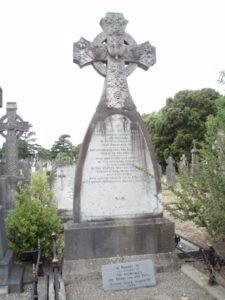
Given the high profile of the case several pleas were made for clemency including from the writer Victor Hugo. O’Donnell’s estranged wife travelled from America to plead his case but arrived after the sentence had been pronounced.
Fourteen Irish American Democratic Congressmen lobbied the American President Chester A Arthur, who officially petitioned on behalf of O’Donnell, once it was determined he had acquired American citizenship. The British government rejected this plea for clemency, and it was denied.
Patrick O’Donnell was executed on the 17th of December 1883 Hanged at Newgate prison.
Though buried in London, a poignant ceremony later took place in his native Gweedore. On the 22nd of January 1884, a mass was held to repose the soul of Patrick O’Donnell. An empty coffin was then interned in the O’Donnell family plot and his coffin bore the inscription:
O’Donnell was hanged in December 1883, despite pleas for clemency from, among others, Victor Hugo and American President Chester A Arthur.
“Sacred to the memory of Patrick O’Donnell, executed at London 17 December 1883”.
In New York, an Irish Republican ladies group arranged for a memorial to be erected in Glasnevin cemetery. It reads:
“In Memory of Patrick O’Donnell. Who heroically gave up his life for Ireland in London, England 17 December 1883. Not tears but prayers for the dead who died for Ireland”.
A plaque commemorating O’Donnell’s execution stands at his birthplace, Mín an Chladaigh in the parish of Gaoth Dobhair.
A monument to Patrick O’Donnell in Derrybeg was unveiled in 1956 by Cormac Breslin TD. A Celtic cross stands beside Pete’s Bar in Gweedore on the N56, its inscription reads as follows:
I ndíl chuimhe ar Phádraig Ó Domhnaill as paróiste Ghaoth Dobhair a cuireadh chun báis i bpríosún Newgate i Londain ar an 17 Nollaig 1883 de thairbhe a ard dhílseachta d’Éirinn
which translates as:
In memory of Patrick O’Donnell from the parish of Gweedore who was put to death in Newgate Prison in London on 17 December 1883 because of his high loyalty to Ireland.
It may be 137 years since Patrick O’Donnell was executed but his fascinating story and his memory are still remembered in his native Gweedore.
Sources:
- Wiggins Patch Massacre IrishCentral.com
- The Legend of the Molly Maguires by Matt Loy, supplemented by Matthew R Hengeveld
- historicalcrimedetective.com/the-mollie-maguires/
- Kevin Kenny ‘Making sense of the Molly Maguire’s
- Lord Frederick Cavendish and the Phoenix Park murders of 1882 History Ireland 2014
- Irish Conspiracies. Recollections of John Mallon 1910
- L.McCracken, ‘The death of the informer James Carey: a Fenian revenge killing?
- L.McCracken, ‘The death of the informer James Carey: a Fenian revenge killing?
- L.McCracken, ‘The death of the informer James Carey: a Fenian revenge killing?
- Revenge of the Fenians – A jubilee in Ireland over Carey’s murder” New York Times. 2 August 1883.
- L.McCracken, The Fate of an Infamous Informer. Dublin: History Ireland 2001
- Senan Moloney, The Phoenix Murders: Conspiracy, Betrayal and Retribution. Dublin: